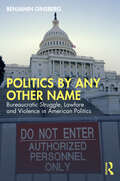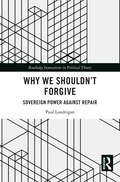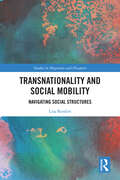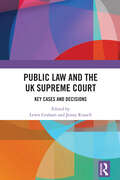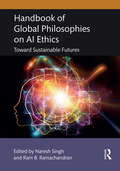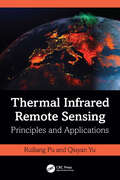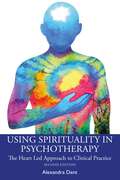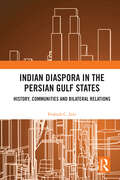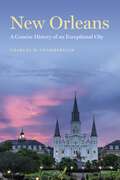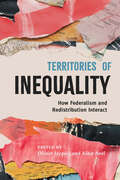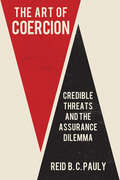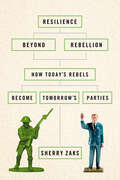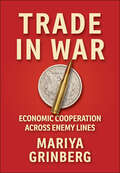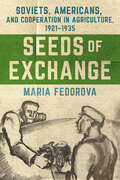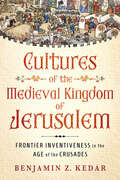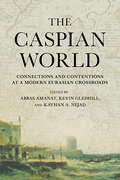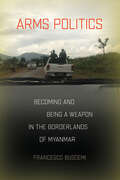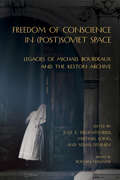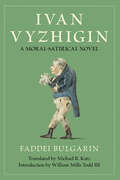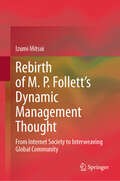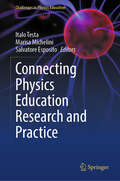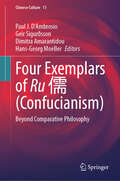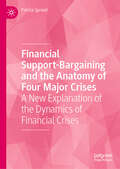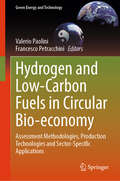- Table View
- List View
Politics by Any Other Name: Bureaucratic Struggle, Lawfare and Violence in American Politics
by Benjamin GinsbergThis book critiques a modern U.S. political system characterized by the partisan weaponization of bureaucratic systems and institutions.Competition for political power in the United States today is not just about winning elections. Competing political forces attempt to win at the polls, but they do not bet all their chips on electoral outcomes. Each party has built an institutional bastion within portions of the federal bureaucracy. Each party makes use of judicial and criminal proceedings for partisan purposes—a practice dubbed “lawfare” by the national media. And, acting through various surrogates, each party sponsors “violence by proxy,” to achieve its ends. To the extent that political struggles are fought outside the electoral arena, ordinary Americans have little or no voice in public affairs. And, unfortunately, in the United States today, a good deal of political struggle takes place outside the electoral arena.This book will be used in undergraduate and graduate classes in political parties, electoral politics, and in general U.S. government classes.
Why We Shouldn’t Forgive: Sovereign Power Against Repair (Routledge Innovations in Political Theory)
by Paul LondriganWhy We Shouldn’t Forgive invites you to understand how the practice of political forgiveness and sovereignty has changed, evolved, and developed over time.Political forgiveness is an awesome power that bears the promise of great benevolence, but this does not mean, as Paul Londrigan argues, that we should forgive. By engaging with the subject of political forgiveness in relation to sovereignty, Londrigan offers original insights into forgiveness as part of an analysis of prerogative power. As a result, what forgiveness does, and how it has been understood in the history of political thought, becomes intelligible. Six substantive chapters that investigate and substantiate the argument that we should not forgive follow the introduction. Each chapter adopts a seminal figure in the history of political thought beginning with Niccolò Machiavelli, and charts a course through Jean Bodin, Thomas Hobbes, John Locke, and Alexis de Tocqueville. As the chapters unfold across thinkers and through time, they build on one another. The resulting narrative illustrates how political forgiveness and sovereign power have evolved, and crucially, how the anxieties and preoccupations of his interlocutors change in accordance with who exercises sovereignty and who benefits or suffers from the dispensation of forgiveness.Why We Shouldn’t Forgive fills an important gap in advancing this fascinating field of research. This book is required reading for students and academics interested in contemporary approaches to reparative politics, studies of post-conflict reconciliation, and those who seek a deeper understanding of the politics of pardon and amnesty, as well as scholars who engage with critiques of sovereign power.
Transnationality and Social Mobility: Navigating Social Structures (Studies in Migration and Diaspora)
by Lisa BonfertConsidering that changes in people’s life chances are increasingly shaped by cross-border movements and transnational connections, this book proposes a transnational conception of social mobility. Emphasising the manifold ways in which contexts of migration and transnationality affect perceptions and evaluations of betterment, the book argues for linking the study of social and spatial mobility to better capture how people navigate social structures of inequality in a globalised world.Based on the experiences of people who moved to Germany to improve their lives in some way, this book links empirical findings with theoretical considerations from transnational and intersectional scholarship to propose an alternative concept of social mobility that emphasises people’s subjective interpretations of success and failure in their search of betterment.Drawing on the concepts of social spaces, capitals, and reference group theory, a model of the cogwheels of social mobility is proposed to account for the varying ways in which cross-border migration and transnational connections initiate changes in people’s social position within and across country borders.This book will therefore be of interest to scholars of sociology, geography and politics with interests in migration, transnationalism and mobility.
Public Law and the UK Supreme Court: Key Cases and Decisions
by Lewis Graham Jenny RussellThis volume brings together expert commentators across different fields of public law to comment on key decisions by the UK Supreme Court (UKSC).Each author explores their case’s content, as well as its broader implications for public law as a field and the Supreme Court as an institution. The work is divided into the following areas: constitutional law, administrative law and judicial review, human rights, and criminal law and criminal justice. Providing expert commentary on recent authorities of the highest level in one place, the collection will enable readers interested in these areas to conveniently locate analysis that will aid them in their work. Taken together, the contributions enable identification of persistent themes within subject areas.As such, it will be an invaluable resource for academics, researchers, practitioners, judges, and policymakers.
Handbook of Global Philosophies on AI Ethics: Toward Sustainable Futures
by Naresh Singh Ram B. RamachandranThis book offers an exploration of the diverse perspectives shaping the future of artificial intelligence (AI), highlighting the influence of non-Western thinking in its development. What would the impact be if AI were developed with the wisdom of Ubuntu, the harmony of Confucian thought, or the Indian principle of Vasudhaiva Kutumbakam, "the world is one family", at its core? This thought-provoking collection brings together leading voices from around the globe to reimagine AI systems that are fair, ethical, and inclusive. Addressing critical issues such as bias, fairness, privacy, and existential risks, it challenges the status quo and envisions a future where AI reflects the values of all humanity—not just a select few. Exploring the influence of topics like religion, culture, and social movements, the book examines how these perspectives shape AI’s application in industries such as finance, education, and the military, while underscoring the importance of establishing robust ethical guardrails. Whether you’re a curious reader, a policy maker, a scholar, or a tech innovator, this book is your guide to understanding how different cultural perspectives can redefine AI ethics. It’s time to ask: what kind of world do we want AI to build for us all?
Thermal Infrared Remote Sensing: Principles and Applications
by Ruiliang Pu Qiuyan YuThis book systematically and comprehensively introduces concepts, theories, principles, and applications of Thermal Infrared (TIR) imaging spectral techniques and TIR remote sensing. It introduces in detail algorithms, techniques, and methods for processing and analyzing TIR data, including radiometric calibration and atmospheric correction in TIR region, retrieving land surface emissivity and temperature (LST) from various TIR data, and downscaling LST and TIR radiance spatiotemporally. Focusing on TIR-RS application orientation, this book introduces state-of-the-art techniques and methods applied in areas such as hydrology, biomass burning, urban thermal environment, and other areas of interest.Features: Presents a complete coverage of thermal infrared remote sensing, from concepts to applications. Provides a thorough survey of characteristics and types of airborne and spaceborne TIR sensors, systems, and missions. Discusses principles and methods of radiometric calibration and atmospheric correction for correcting TIR data. Includes case studies that demonstrate the applicability and potential of a variety of techniques and methods to process TIR data. Offers a comprehensive review of TIR remote sensing applications. This book is a great resource for professionals in the academic and corporate world and an insightful reference for graduate and senior undergraduate students studying geology, geography, geophysics, and environments, as well as natural resources and survey management.
Using Spirituality in Psychotherapy: The Heart Led Approach to Clinical Practice
by Alexandra DentUsing Spirituality in Psychotherapy: The Heart Led Approach to Clinical Practice offers a means for therapists to integrate a spiritual perspective into their clinical practice.The book provides a valuable alternative to traditional forms of psychotherapy by placing an emphasis on purpose and meaning. Introducing a spiritually informed model, Heart Led Psychotherapy (HLP), the book uses a BioPsychoSocioSpiritual approach to treat psychological distress. Based on the premise that everyone is on an individual life journey, HLP teaches clients to become an observer, identifying the life lessons that they are being asked to understand or experience. The model can be used whether a client has spiritual beliefs or not, enabling them to make new choices that are in keeping with their authentic selves and to live a more fulfilled and peaceful life. This new edition includes updated references and new material on transpersonal psychology, spiritual awakening, working within the quantum field, significance of the heart and heart coherence.Illustrated by case studies to highlight key points and including a range of practical resource exercises and strategies, this engaging book will have wide appeal to therapists and clinicians from a variety of backgrounds.
Indian Diaspora in the Persian Gulf States: History, Communities and Bilateral Relations
by Prakash C. JainIndian Diaspora in the Persian Gulf States focuses on the historical as well as the contemporary aspects of the Indian diaspora of the region where small Indian merchant communities called Banians already existed for centuries. Persian Gulf countries emerged as rentier states since the 1970s, mainly due to the development of the oil industry, which transformed the region from subsistence to globalized capitalist economies. In these economies, the role of sponsored Indian expatriate immigrants numbering at least 20 million during the past half century was vitally important. Taking the rentier state as the theoretical perspective, the author argues that the sponsorship (kafala) system tended to have a different impact on the Indian expatriates: incorporation and promotion of the entrepreneurs and professionals as business elites and the perpetual exploitation of the working classes. The book is not only the first-ever definitive and comprehensive work on the Indian diaspora in the nine countries of the Gulf region, it also stands as the author’s final statement on his three-odd decades of research and writing on the subject. Besides highlighting the role of Indian diaspora, the book also profiles all the Gulf-based recipients of the Pravasi Bharatiya Samman Awards. Bilateral trade, investment and political relations between India and individual Persian Gulf states constitute another focus area of the volume. The volume will be an interesting read for teachers, researchers and policy-makers connected with migration and diaspora studies, labour studies, political economy, international relations and geopolitics.
New Orleans: A Concise History of an Exceptional City
by Charles D. ChamberlainIntended for general readers, Charles D. Chamberlain’s New Orleans: A Concise History of an Exceptional City offers a broad, reliable overview of the city’s history. Although many excellent books are available that focus on specific eras in the Crescent City, this book is the first fully inclusive scholarly history that is engaging and easy to follow.In addition to a general historical narrative, each chapter provides a list of relevant historical sites and a carefully selected recipe to make the city’s history come to life through site visits and culinary pursuits. Chamberlain encourages readers to experience the spirit of New Orleans first-hand by exploring its landscape and interacting with its cuisine.New Orleans: A Concise History of an Exceptional City is a trusty reference for tour guides and a valuable, interactive resource for general readers interested in the fascinating history of one of America’s most unique cities.
Territories of Inequality: How Federalism and Redistribution Interact (Democracy, Diversity, and Citizen Engagement Series)
by Alain Noël Olivier JacquesThe rise of income and wealth inequality and the possibilities of redistribution animate contemporary social and political debates, but much of the scholarship on the issue is limited to the individual level. There is a spatial dimension to the redistribution of income, however, and in federations, this is especially important.In Territories of Inequality leading political scientists propose a territorial approach to inequality and redistribution, informed by political economy, political geography, and a comparative analysis of federalism and multilevel governance. Chapters explore the relationship between interpersonal and interregional redistribution, the role of progressive or regressive governing coalitions, and the foundations of individual preferences for or aversions to interregional redistribution. They consider different federations and quasi-federations and emphasize the unique situation of Indigenous Peoples, who navigate a complex relationship with institutions shaped by colonialism.Examining how decentralization and federalism influence policy outcomes and public preferences, Territories of Inequality provides new ways to approach the question of redistribution.
The Art of Coercion: Credible Threats and the Assurance Dilemma (Cornell Studies in Security Affairs)
by Reid B. PaulyThe Art of Coercion presents a fresh explanation for the success—and failure—of coercive demands in international politics.Strong states are surprisingly bad at coercion. History shows they prevail only a third of the time. Reid B. C. Pauly argues that coercion often fails because targets fear punishment even if they comply. In this "damned if you do, damned if you don't" scenario, targets have little reason to obey. Pauly illustrates this logic in nuclear counterproliferation efforts with South Africa, Iraq, Libya, and Iran. He shows that coercers face an "assurance dilemma": When threats are more credible, assurances not to punish are less so. But without credible assurances, targets may defy threats, bracing for seemingly inevitable punishment. For coercion to work, as such, coercers must not only make targets believe that they will be punished if they do not comply, but also that they will not be if they do. Packed with insights for any foreign policy challenge involving coercive strategies, The Art of Coercion crucially corrects assumptions that tougher threats alone achieve results.
Resilience beyond Rebellion: How Today's Rebels Become Tomorrow's Parties
by Sherry ZaksResilience beyond Rebellion addresses a critical question in insurgency studies: Why some rebel groups successfully become political parties, while others die trying. Only half of rebel groups with political aspirations manage to reinvent themselves as lasting political parties. Sherry Zaks argues that the key to successful rebel-to-party transformations lies in the organizational structures and institutions that rebels build during wartime. These proto-party structures, which involve governance, political messaging, social outreach, and other noncombat tasks, equip rebel groups with the personnel, skills, and routines needed to succeed in the electoral arena.Zaks draws on insights from organizational sociology to reconceptualize how rebel groups operate. Through examining the Farabundo Martí National Liberation Front in El Salvador and other cases, they demonstrate that rebel groups with established proto-party structures often form the core of post-conflict parties and attract more votes. Innovative in approach and rich in evidence, Resilience beyond Rebellion advances our understanding of rebel group dynamics both during and after conflict by showing that party-building begins not with the last bullet fired but with the very first.
Trade in War: Economic Cooperation across Enemy Lines (Cornell Studies in Security Affairs)
by Mariya GrinbergTrade in War is an urgent, insightful study of a puzzling wartime phenomenon: states doing business with their enemies. Trade between belligerents during wartime should not occur. After all, exchanged goods might help enemies secure the upper hand on the battlefield. Yet as history shows, states rarely choose either war or trade. In fact, they frequently engage in both at the same time. To explain why states trade with their enemies, Mariya Grinberg examines the wartime commercial policies of major powers during the Crimean War, the two World Wars, and several post-1989 wars. She shows that in the face of two competing imperatives—preventing an enemy from increasing its military capabilities, and maintaining its own long-term security through economic exchange—states at war tailor wartime commercial policies around a product's characteristics and war expectations. If a product's conversion time into military capabilities exceeds the war's expected length, then trade in the product can occur, since the product will not have time to affect battlefield outcomes. If a state cannot afford to jeopardize the revenue provided by the traded product, trade in it can also occur. Grinberg's findings reveal that economic cooperation can thrive even in the most hostile of times—and that interstate conflict might not be as easily deterred by high levels of economic interdependence as is commonly believed. Trade in War compels us to recognize that economic ties between states may be insufficient to stave off war.
Seeds of Exchange: Soviets, Americans, and Cooperation in Agriculture, 1921–1935 (NIU Series in Slavic, East European, and Eurasian Studies)
by Maria FedorovaSeeds of Exchange examines the US and Soviet exchange of agricultural knowledge and technology during the interwar period. Maria Fedorova challenges the perception of the Soviet Union as a passive recipient of American technology and expertise. She reveals the circular nature of this exchange through official government bureaus, amid anxious farmers in crowded auditoriums, in cramped cars across North Dakota and Montana, and by train over the once fertile steppes of the Volga. Amid the post–World War I food insecurity, Soviet and American agricultural experts relied on transnational networks, bridging ideological differences. As Soviets traveled across the US agricultural regions and Americans plowed steppes in the southern Urals and the lower Volga, both groups believed that innovative solutions could be found beyond their own national borders. Soviets were avidly interested in American technology and American agricultural experts perceived the Soviet Union to be an ideal setting for experimenting with and refining modern farm systems and organizational practices. As Seeds of Exchange shows, agricultural modernization was not the exclusive domain of Western countries.
Cultures of the Medieval Kingdom of Jerusalem: Frontier Inventiveness in the Age of the Crusades (Medieval Societies, Religions, and Cultures)
by Benjamin Z. KedarCultures of the Medieval Kingdom of Jerusalem is a revelatory portrait of the Frankish Levant at the time of the Crusades. Following victory in the First Crusade in 1099, the newcomers from Europe, or Franks, ruled a Christian kingdom in Jerusalem, then Acre, until 1291. Historians have written off this kingdom as a derivative cultural backwater. In this new social and cultural history, however, Benjamin Z. Kedar uncovers the striking inventiveness of the Frankish clerics and knights who settled in the kingdom and lived in it. Across an array of languages and archives, from textual and artistic to material and archaeological, Kedar maps the contours of the kingdom's cultureor, more accurately, its cultures. The Kingdom of Jerusalem was small, but the diversity of its population had no counterpart anywhere in the medieval West. Kedar explores how Franks, eastern Christians, Muslims, Jews, and Samaritans lived side by side in contentious times, each group developing or preserving its specific culture. Through stories of the lives of the kingdom's inhabitants, Kedar presents the remarkable creativity of the Franks in various fields as they faced challenges in new surroundings thousands of miles from their countries of origin. Cultures of the Medieval Kingdom of Jerusalem, the culmination of Kedar's half century of scholarship on the Crusades and the medieval Levant, is an innovative history of the Kingdom of Jerusalem.
The Caspian World: Connections and Contentions at a Modern Eurasian Crossroads
by Abbas Amanat Kevin Gledhill Kayhan A. NejadThe Caspian World is a wide-ranging exploration of the strategic, political, and commercial significance of the Caspian Sea, a site where empires—Russian, Persian, Ottoman, and British—competed, warred, and collaborated. As with the Mediterranean, the Indian Ocean, or the Black Sea, the geography of the Caspian Sea creates a sphere of unique political dynamics and possibilities, and the essays in this volume describe the role of the Caspian as a force of connection, as well as a source of threats, to the states on its shores.Rather than narrating history through binary, state-to-state relationships, however, The Caspian World uncovers the sea as a space of multi-sided exchanges and numerous centers, tracing how the Caspian has shaped the commercial, intellectual, diplomatic, and imperial projects throughout the region.Contributors: Ulfat Abdurasulov, Abbas Amanat, Elena Andreeva, George Bournoutian, Iurii Demin, Layla S. Diba, Etienne Forestier-Peyrat, Kevin Gledhill, Guido Hausmann, Kayhan A. Nejad, Matthew P. Romaniello, Saghar Sadeghian, Alisa Shablovskaia, Ernest Tucker, Denis V. Volkov, Murat Yaşar, Rustin Zarkar
Arms Politics: Becoming and Being a Weapon in the Borderlands of Myanmar
by Francesco BuscemiIn Arms Politics, Francesco Buscemi tells the story of the ceasefire, disarmament, and rearmament of the Ta'ang movement in Myanmar's Shan State through an analysis of the formation of the Palaung State Liberation Front/Ta'ang National Liberation Army (PSLF/TNLA). With a focus on the circulation of weapons through the post-1991 ceasefire, disarmament, and rearmament years, Buscemi explores how "becoming and being" an armed force leads to the "becoming and being" of a rebel polity.Buscemi argues that the governance of arms and weaponry by rebel movements such as the PSLF/TNLA shapes historically and spatially complex relationships among leadership, rank-and-file, civilians, and civil society groups. Furthermore, he demonstrates that it is through the acquisition of weapons and the governing of armed collectives that rebel movements reproduce and shape the collective identity of their polity and its political geography. Against the backdrop of the world's longest ongoing armed conflict, Arms Politics shows how the processes and practices of governing weapons shape social and spatial relations of rule at the edges of state authority.
Freedom of Conscience in: Legacies of Michael Bourdeaux and the Keston Archive (NIU Series in Slavic, East European, and Eurasian Studies)
by Rowan Williams Michael Long Julie K. DeGraffenried Xenia DennenFreedom of Conscience in (Post)Soviet Space, a collection of original essays edited by Julie K. deGraffenried, Michael Long, and Xenia Dennen, is inspired by the work of Michael Bourdeaux, the holdings of the Keston Archive, and continuing questions of freedom of conscience. Ranging from England to Siberia and moving chronologically from 1917 to the twenty-first century, this book reveals the unique organization and methodology behind the Keston's collection of materials and the ways those in the West thought about religion and communism during the Cold War, including the connection between religious liberty and human rights.The essays demonstrate the depth and breadth of current research on religion in communist and postcommunist contexts, a much-needed corrective to contemporary political uses of religious freedom. Bourdeaux's activism and preservation of materials influenced many fields of study, as reflected by contributing authors' varied disciplines—history, theology, sociology, languages, and literature. A preface by the theologian and former Archbishop of Canterbury Rowan Williams comments on Michael Bourdeaux's life and significance.
Ivan Vyzhigin: A Moral-Satirical Novel (NIU Series in Slavic, East European, and Eurasian Studies)
by Faddei BulgarinWith his translation, Michael R. Katz makes available the first bestselling novel in Russia, Faddei Bulgarin's social satire Ivan Vyzhigin (1829). The novel is an amusing picaresque filled with local color and comical portraits, narrated by its hero, an orphaned peasant who relates his many adventures as a young man. The book is remarkable for its accurate descriptions of nineteenth-century Russian day-to-day reality: the clothes, food, surroundings, and characters that Ivan Vyzhigin encounters. Its publication ushered in the age of prose in nineteenth-century Russian literature, and Bulgarin was hailed by Pushkin as a major prose writer. As William Mills Todd III notes in his introduction, Ivan Vyzhigin opens a window onto what Russians were reading between the late eighteenth century and the 1917 Revolution. Along with Todd's introduction, Katz's annotations provide literary, historical, and cultural context.
Rebirth of M. P. Follett’s Dynamic Management Thought: From Internet Society to Interweaving Global Community
by Izumi MitsuiThe purpose of this book is to reevaluate the dynamic management thought of M. P. Follett (1868–1933) and recreate it for the construction of a new society after the COVID-19 era. Here, the focus is especially on the main concept of her dynamic social process concept, &“interweaving&”, and showing its current applicability. It should also be noted that the time Follett created this concept was when the 1918 pandemic (&“Spanish flu&”) struck Boston. Based on her academic background in political science, philosophy, history, psychology, and related disciplines, Follett had many years of practical experience as a social worker in Boston and advocated a social view based on the dynamic interaction of individuals. It included &“rebuilding social relations&”, &“social development as a continuous process&”, and &“creating a community experience through the interweaving of individual experiences&”. One of the important issues that COVID-19 poses is the breaking and restructuring of human relations in communities and societies. The author believes that such an issue could be easily resolved by information and communications technology (ICT) networks. While it is a powerful tool, we are now aware that it also has the effect of isolating individuals and inciting conflicts. The author applies Follett&’s ideas to approach such problems. In this book, her perspectives on the &“interweaving process of experience&” and its position are emphasized as important concepts for creating new communities for the post-COVID-19 era. Expressed symbolically, they correspond to interweaving experiences in the internet society.
Connecting Physics Education Research and Practice (Challenges in Physics Education)
by Salvatore Esposito Marisa Michelini Italo TestaThis book presents a selection of the most recent research results from the Italian physics education research community, aimed at enhancing the teaching and learning of physics. The motivation for this publication arises from the lack of a comprehensive reference for teachers on research results in physics education. Despite various physics curriculum reform initiatives, such as the introduction of modern physics into high school curricula, their effectiveness in improving the quality of physics teaching in schools has been limited. The book offers a contextualized view of the main topics in physics education, along with a comprehensive overview of the current challenges faced by physics education in Italy and abroad. It also presents research findings that could potentially enhance students' learning of physics. Throughout the book, the implications of these studies are outlined, acknowledging issues and knowledge gaps that will guide future research in physics education. Specifically, rather than covering all the contents addressed in the physics curriculum, the book presents research contributions that suggest potentially effective strategies, methods, and practices at different school levels, from primary school to secondary school and university level. Regarding physics content, the book presents teaching proposals highlighting conceptual aspects and exemplary methodologies of interpretation in physics, such as the physics of fluids and quantum mechanics. It also includes research contributions on different methods and proposals for implementing practical activities, reflecting on the role of the laboratory in learning the discipline and providing examples of integrating experimental and cognitive skills. The book also addresses the role of affective variables, such as physics identity, self-efficacy, and attitudes toward physics in the learning process. Additionally, studies on teachers&’ professional development are presented, which can inform the design of proposals for educational paths and methods, within a framework of close collaboration between schools and physics departments.
Lidchirurgie: Ein Praxisbuch
by Matthias Keserü Simon DulzVeränderungen der Augenlider benötigen eine spezielle Betrachtung durch den okuloplastischen Chirurgen im Schnittpunkt zwischen Funktion und Ästhetik der periorbitalen Region. Dieses Buch bietet intensive Einblicke in die Lidchirurgie und richtet seinen Fokus praxisnah auf die Indikationsstellung, OP-Techniken, das Komplikationsmanagement und die Nachsorge der häufigsten lidchirurgischen Erkrankungen und Eingriffe. Dabei wird sowohl auf die funktionelle als auch auf die ästhetische okuloplastische Chirurgie eingegangen. Die behandelten Themen reichen von häufigen Krankheitsbildern wie Entropium, Ektropium, Ptosis und Dermatochalasis bis hin zur Ober- und Unterlidblepharoplastik, Tumorchirurgie und komplexen Lidrekonstruktionen. Die praxisorientierte Gliederung ermöglicht eine schnelle und gezielte Einarbeitung in alle Bereiche der Lidchirurgie und bietet sowohl Einsteigern als auch fortgeschrittenen Lidchirurgen eine wertvolle Hilfestellung. Verbessern Sie Ihre okuloplastische Expertise mit Tipps von erfahrenen Operateuren.
Four Exemplars of Ru 儒: Beyond Comparative Philosophy (Chinese Culture #11)
by Hans-Georg Moeller Paul J. D'Ambrosio Geir Sigurðsson Dimitra AmarantidouThis book discusses scholars who have all engaged in comparative philosophy projects, many of whom first rose to fame because of their penetrating insights into the similarities and differences in “Western” and “Chinese” thought. They all went beyond simply looking at how one thinker, one school, or one tradition relates to another: each draws on sources from China and the West. However, their projects—from role ethics to concrete metaphysics, from critiquing individualism to balancing harmony and justice—are attempts at re-evaluating the way we view the world and live our lives. These projects are systematic, thorough tong 通, and comprehensive descriptions of ourselves, the world, and our interactions with others. They are all comparative, but, on top of this, they also aim at making a point that transcends their comparisons. The book thus shows that these great thinkers draw on a multiplicity of resources, and while they might find some ideas closer to home than others, comparison is a necessary constant. Using traditional Confucian vocabulary, this type of philosophizing is described as practicing xue 学, normally understood as “studying” or “learning.” But, it also means to copy, imitate, model, or emulate. In the process of xue, one imitates, but with a nod to differences. This book honors four models of such an attitude to xue. In its examination of some of the most influential scholars in Chinese thought, this is a seminal book for scholars and students in Chinese and comparative philosophy.
Financial Support-Bargaining and the Anatomy of Four Major Crises: A New Explanation of the Dynamics of Financial Crises
by Patrick SpreadThis book takes a detailed look at four major financial crises—the twin crises of the South Sea Bubble in Britain and the Mississippi Bubble in France in 1720; the Great Crash of 1929 and the subsequent Great Depression; and the Global Financial Crisis of 2007-9. It traces the evolution and causes of the crises by reference to a theory of support-bargaining and money-bargaining, set out in earlier work, but reintroduced here with specific reference to financial crises. Two early chapters focus on theoretical issues. The work of prominent theorists, including John Law and J. M. Keynes, is evaluated. A fundamental problem of neoclassical theory is its failure to accommodate time disparities, and consequent credit requirements, in economic transactions. This has necessitated theoretical separation of a &‘real economy&’ from financial markets. The separation renders neoclassical economists blind to financial services, and hence to the dynamics of financial crises. In support-bargaining and money-bargaining, the &‘real economy&’ and financial services are seamlessly linked. The book shows how the theory of support-bargaining and money-bargaining provides a clear and consistent explanation of the incidence of financial crises. Since financial crises are not exceptional events, the wider aim of the book is to convince social scientists that, in explaining financial crises, the theory of support-bargaining and money-bargaining provides also a superior explanation of the functioning of economies and societies in quieter times. It will appeal particularly to those many economists who find the prevalent neoclassical model of economic transactions inconsistent with the observable functioning of economies.
Hydrogen and Low-Carbon Fuels in Circular Bio-economy: Assessment Methodologies, Production Technologies and Sector-Specific Applications (Green Energy and Technology)
by Valerio Paolini Francesco PetracchiniThis book explains how decarbonisation of transport connects to the wider project of making more sustainable and circular society. Emissions reduction in the transportation sector has become a critical challenge for both mitigating climate change and reducing diseases due to air pollution. However, transport decarbonization is also strongly connected to the urgent need of an increased resource efficiency and a transition towards a more sustainable, bio-based and circular society. This book describing the technology and the potential application of hydrogen and low carbon fuels. In the first section, it lays out the general principles and assessment methodologies, including the evaluation of local and global impacts from an environmental, economic and social perspective. Subsequently, the second section describes the technology to produce sustainable fuels including electrolytic hydrogen and electro-methane, bio-hydrogen, gaseous and liquid biofuels. Finally, in the book&’s last section, specific case studies are provided including urban and long-range wheel transport, as well as rail, navigation and airplane applications.
